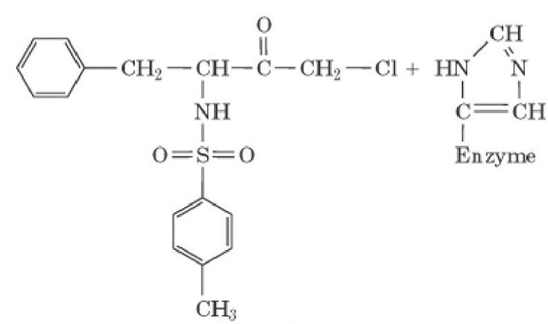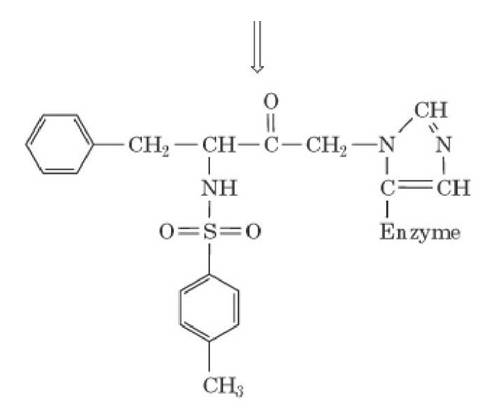
Concept explainers
Answers to all problems are at the end οΓthis book. Detailed solutions are available in the Student Solutions Manual. Study Guide, and Problems Book.
Characterizing a Covalent Enzyme Inhibitor Tosyl-L-phenylalanme cfaloromethyl

- Propose a mechanism for the inactivation reaction, indicating the structure of the produce(s).
- State why this inhibitor is specific tor cJiymotrypsin.
- Propose a reagent based on the structure of TPCK that might be an effective inhibitor of trypsin.
a.
To propose: The mechanism for the inactivation reaction which indicates the structure of the products.
Introduction:
Covalent enzyme inhibitor like TPCK is slowly reversible or totally irreversible. In many cases, these inhibitors are used to validate the pathway or target. There are targeted covalent enzyme inhibitors that have a slow offset, high binding efficiency as well as high potency to bind, increased selectivity decreased propensity for target-based drug resistance and prolonged pharmacodynamic effect.
Explanation of Solution
Chymotrypsin undergoes covalent inactivation reaction by nucleophilic attack on the
So, the mechanism of inactivation reaction is given below:


Hence, from the above discussion, it is clear that chymotrypsin undergoes covalent inhibition reaction.
b.
To propose: The reason for this inhibitor to be specific for chymotrypsin.
Introduction:
Covalent enzyme inhibitor like TPCK is slowly reversible or totally irreversible. In many cases, these inhibitors are used to validate the pathway or target. There are targeted covalent enzyme inhibitors that have a slow offset, high binding efficiency as well as high potency to bind, increased selectivity decreased propensity for target-based drug resistance and prolonged pharmacodynamic effects. Chymotrypsin plays an important part in the breakdown of proteins which is called proteolysis. The pancreas synthesizes the chymotrypsin. It cleaves the peptide amino bonds to digest the proteins.
Explanation of Solution
The inhibitor is chymotrypsin specific because the chloromethyl keto group reaches the active site by the hydrophobic reactions of chymotrypsin and the phenyl group of TPCK.
Hence, from the above discussion, it is clear that the inhibitor is chymotrypsin specific.
c.
To identify: A reagent that can be an effective inhibitor of Trypsin.
Introduction:
Chymotrypsin plays an important part in the breakdown of proteins which is called proteolysis. The pancreas synthesizes the chymotrypsin. It cleaves the peptide amino bonds to digest the proteins.
Explanation of Solution
The phenylalanine residue of TPCK has to be replaced with lysine or arginine to produce the specific reagents for the enzyme Trypsin.
Hence, from the above discussion, it is clear that the residual portion of TPCK only produces the specific reagent for Trypsin.
Want to see more full solutions like this?
Chapter 14 Solutions
BIOCHEMISTRY II >CUSTOM<
- Br Mg, ether 1. HCHO (formaldehyde) 2. H+, H₂O PCC 1. NH3, HCN ? (pyridinium chlorochromate) 2. H2O, HCI 11. Which one of the following compounds is the major organic product of the series of reactions shown above? Ph. Ph. OH NH2₂ A Ph. Ή NH2 B OH Ph Η Ph OH NH2 NH2₂ NH₂ C D Earrow_forwardB A 6. Which ONE of the labeled bonds in the tripeptide on the right is a peptide bond: H₂N N 'N' OH C H A, B, C, D or E? HN E OHarrow_forwardQuestions 8-9 are 0.4 points each. The next two questions relate to the peptide whose structure is shown here. To answer these questions, you should look at a table of H2N/.. amino acid structures. You don't have to memorize the structures of the amino acids. IZ 8. What is the N-terminal amino acid of this peptide? A) proline B) aspartic acid C) threonine 9. What is the C-terminal amino acid of this peptide? A) proline B) aspartic acid C) threonine N OH D) valine E) leucine D) valine E) leucine NH "OH OHarrow_forward
- 7. What is the correct name of the following tripeptide? A) Ile-Met-Ser B) Leu-Cys-Thr C) Val-Cys-Ser D) Ser-Cys-Leu E) Leu-Cys-Ser H₂N!!!!! N H ΖΙ .SH SF H IN OH OHarrow_forwardPlease draw out the following metabolic pathways: (Metabolic Map) Mitochondrion: TCA Cycle & GNG, Electron Transport, ATP Synthase, Lipolysis, Shuttle Systems Cytoplasm: Glycolysis & GNG, PPP (Pentose Phosphate Pathway), Glycogen, Lipogenesis, Transporters and Amino Acids Control: Cori/ Glc-Ala cycles, Insulin/Glucagon Reg, Local/Long Distance Regulation, Pools Used Correctlyarrow_forwardPlease help provide me an insight of what to draw for the following metabolic pathways: (Metabolic Map) Mitochondrion: TCA Cycle & GNG, Electron Transport, ATP Synthase, Lipolysis, Shuttle Systems Cytoplasm: Glycolysis & GNG, PPP (Pentose Phosphate Pathway), Glycogen, Lipogenesis, Transporters and Amino Acids Control: Cori/ Glc-Ala cycles, Insulin/Glucagon Reg, Local/Long Distance Regulation, Pools Used Correctlyarrow_forward
- f. The genetic code is given below, along with a short strand of template DNA. Write the protein segment that would form from this DNA. 5'-A-T-G-G-C-T-A-G-G-T-A-A-C-C-T-G-C-A-T-T-A-G-3' Table 4.5 The genetic code First Position Second Position (5' end) U C A G Third Position (3' end) Phe Ser Tyr Cys U Phe Ser Tyr Cys Leu Ser Stop Stop Leu Ser Stop Trp UCAG Leu Pro His Arg His Arg C Leu Pro Gln Arg Pro Leu Gin Arg Pro Leu Ser Asn Thr lle Ser Asn Thr lle Arg A Thr Lys UCAG UCAC G lle Arg Thr Lys Met Gly Asp Ala Val Gly Asp Ala Val Gly G Glu Ala UCAC Val Gly Glu Ala Val Note: This table identifies the amino acid encoded by each triplet. For example, the codon 5'-AUG-3' on mRNA specifies methionine, whereas CAU specifies histidine. UAA, UAG, and UGA are termination signals. AUG is part of the initiation signal, in addition to coding for internal methionine residues. Table 4.5 Biochemistry, Seventh Edition 2012 W. H. Freeman and Company B eviation: does it play abbreviation:arrow_forwardAnswer all of the questions please draw structures for major productarrow_forwardfor glycolysis and the citric acid cycle below, show where ATP, NADH and FADH are used or formed. Show on the diagram the points where at least three other metabolic pathways intersect with these two.arrow_forward
 BiochemistryBiochemistryISBN:9781305577206Author:Reginald H. Garrett, Charles M. GrishamPublisher:Cengage Learning
BiochemistryBiochemistryISBN:9781305577206Author:Reginald H. Garrett, Charles M. GrishamPublisher:Cengage Learning
